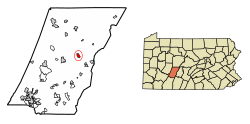Loretto, Pennsylvania | |
|---|---|
Borough | |
 The main house, cascades, and gardens of "Immergrün", Charles M. Schwab's retreat in Loretto | |
 Location of Loretto in Cambria County, Pennsylvania. | |
| Coordinates: 40°30′23″N78°38′10″W / 40.50639°N 78.63611°W | |
| Country | United States |
| State | Pennsylvania |
| County | Cambria |
| Settled | 1788 |
| Incorporated | 1845 |
| Government | |
| • Type | Borough council |
| Area | |
• Total | 0.98 sq mi (2.55 km2) |
| • Land | 0.98 sq mi (2.55 km2) |
| • Water | 0.00 sq mi (0.00 km2) |
| Elevation | 1,952 ft (595 m) |
| Population | |
• Total | 1,196 |
| • Density | 1,215.45/sq mi (469.48/km2) |
| Time zone | UTC-5 (Eastern (EST)) |
| • Summer (DST) | UTC-4 (EDT) |
| ZIP code | 15940 |
| Area code | 814 |
| FIPS code | 42-44704 |
| GNIS feature ID | 1215028 [2] |
Loretto is a borough in Cambria County, Pennsylvania, United States. As of the 2010 census it had a population of 1,302. [4] Like the rest of Cambria County, it is part of the Johnstown, Pennsylvania, Metropolitan Statistical Area. Loretto is the home of Saint Francis University.


